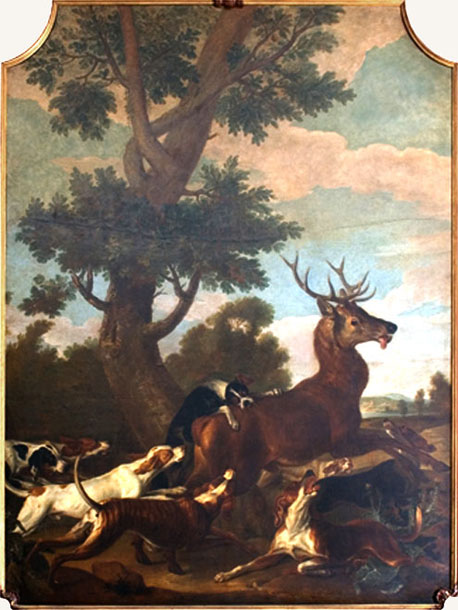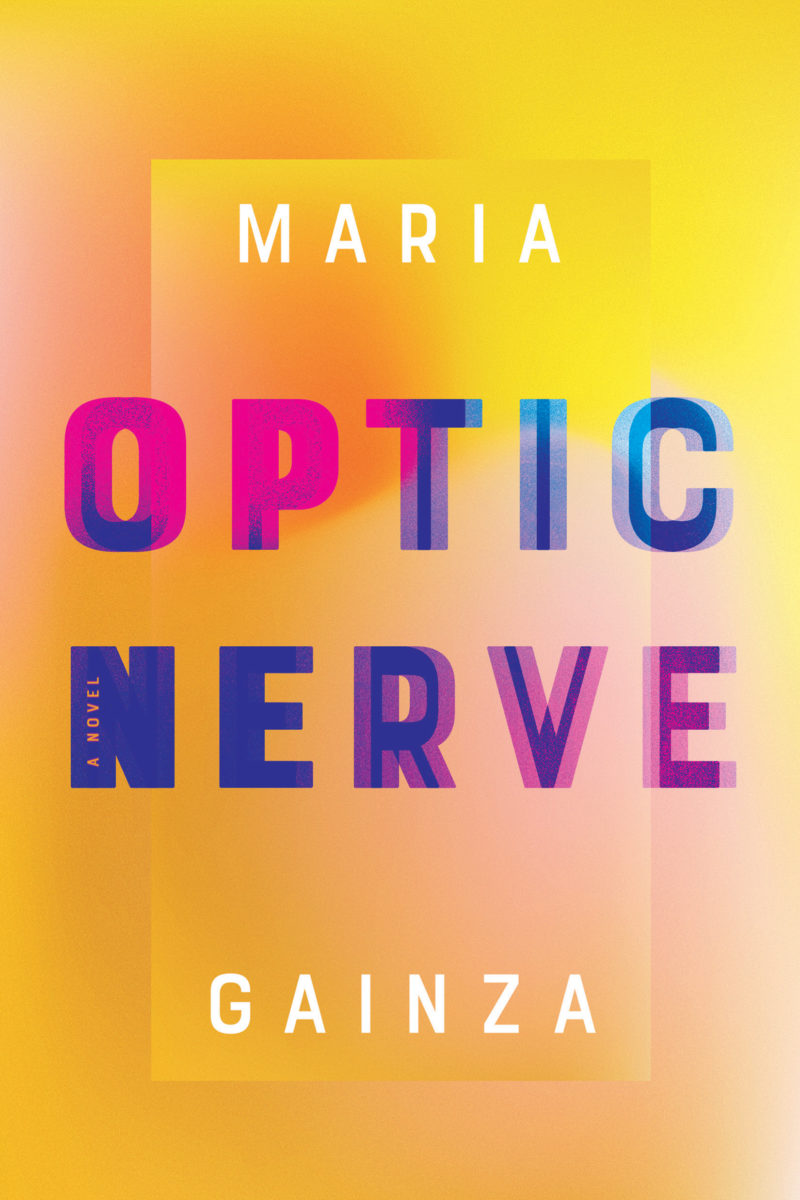
Format: 193 pp., hardcover; Size: 4.5 x 7.5; Price: $25; Jacket Illustration: Nicole Caputo; Publisher: Catapult; Number of Painters Mentioned in the Book: 43; Quotations by Famous People Who Are Not Painters, Some in Paraphrase: 28; Translator: Thomas Bunstead; Representative Passage: “Perhaps there is something spiritual in the experience of looking at a Rothko, but it’s the kind of spiritual that resists description: like seeing a glacier or crossing a desert. Rarely do the inadequacies of language become so patently obvious. Standing before a Rothko, you might reach for something meaningful to say, only to end up talking nonsense. All you want to say is ‘fuck me.’”
Central Question: What does the way we perceive and talk about art tell us about ourselves?
In the beginning of María Gainza’s novel Optic Nerve, the narrator—an Argentinian art historian also named María—encounters a painting by Alfred de Dreux. She remarks that the painting, an image of deer encircled by hunting dogs, was “fairly conventional, no point denying it, but it grabbed me nonetheless. More than that: it unsettled me.” I looked up the painting of Dreux’s Caza del Ciervo online and found it exactly as María describes it: “The deer is about to die. One of the dogs sinks its fangs into the back; another, a leg. The deer, on the verge of giving in, neck elaborately contorted, tongue out, is goggle-eyed with the same helplessness as the hare described in Lampedusa’s The Leopard […]”
María does not mention what is perhaps the painting’s most remarkable aspect: the deer seems to be staring directly at the viewer, in an almost human way. It is unsettling, and oftentimes it seems that María herself gazes back at the reader in a similar way, daring us to make sense of her digressive meditations.
Optic Nerve unfolds as a series of vignettes rather than a cohesive narrative. María wafts through these vignettes, reflecting on subjects ranging from her family’s aristocratic history to the lives of the artists whose work she encounters. The narrator moves digressively from one reflection to the next, making the novel feel like less of a story than a study—not only of art, but also of what our perception of art tells us about our impulse to make meaning, and the ways that endeavor is continually confounded. The sheer number of artistic and literary references that appear in the novel is impressive, ranging from Marguerite Duras to Buzz Aldrin. At times these references feel like matches lit in a dark corridor, meant to illuminate, however obliquely, some aspect of María’s memories that she cannot access without some assistance. At other times, they seem like conscious diversions. Although the novel is rife with tragedies (the death of María’s brother, an older cousin’s suicide, her best friend’s disappearance, and later, her own illness), no single tragedy drives the plot. Instead, the narrator moves through her vignettes much like she might a series of paintings in a gallery. She submits them to her penetrating gaze, meticulously describing them and the feelings that they stir up. As soon as we are led to believe that she will draw some conclusion about their significance or meaning, however, she moves on. On one hand, María’s itinerant gaze might mark aesthetic sophistication; on the other, it might only be a sign of her inability to grapple with the emotional weight of loss.
María mentions, one assumes at least somewhat tongue-in-cheek, that she has “realized that being good with quotations means avoiding having to think for oneself.” This is learned. After all, as a daughter of the aristocracy María has been taught to concern herself with appearances. As a result, she views everything, even herself, from the outside. Her obsession with art is both an effort to escape that narrow aristocratic tendency, and proof of how powerless she is to escape it. María may be a self-proclaimed “destroyer of images,” the prodigal daughter willfully stepping out of privilege, but she cannot help seeking shelter in the ruins of the family’s aristocratic past, of which her obsession with art is one manifestation. María confesses that whenever she’s feeling unmoored, she returns to galleries. “Whenever I’m in survival mode like this I find myself drawn irresistibly to museums and galleries,” she says, “like people running for air raid shelters in wartime.” María’s impulse to run to art galleries recalls how her mother fled to her childhood home, a mansion that later became a U.S. embassy, whenever anything went wrong. But if art is a refuge, it is also a source of potential confinement; in one wry anecdote, María’s mother is trapped between a mirror and a pile of Sotheby’s catalogs until the maid finally hears her cries and rescues her. In another, we learn of the narrator’s Uncle Marion, who, given the opportunity to design his own room, essentially constructed himself a gilded cage. And the novel itself is carried by an undercurrent of the narrator’s own relentless cataloging of artwork, which comes to resemble a trap.
And yet, unlike her other family members, the narrator seems aware that her obsession with looking outward is a reflection of captivity, not freedom. María encounters a painting by Schaivoni that resembles her as a girl, commenting, “[…] it was the sensation of seeing myself, a version of myself in need of affection, that had acted on me so strongly: I felt like running to the little girl in the picture and throwing my arms around her.” She continues, “Might a great painting not even reformulate the question what is it about to what am I about? Isn’t theory also in some sense always autobiography?” This isn’t a question, but a wish; even if art might answer the question “What am I about?” it remains to María an impenetrable surface. María longs to run through the picture, to embrace her younger self. She cannot, and instead moves to the next artwork, looking for yet another mirror, another passage into her own psychological interior.
At one point, María relates the story of a cousin she visited in a crumbling family house by the seaside. The cousin obsessively covers her walls in magazine collages of blue and green, recalling Uncle Marion’s walls, the mother’s hoarded catalogues, and the galleries that the narrator runs to in distress. The cousin walks around aimlessly at night, but confesses that she doesn’t know what she is looking for. She shows the narrator the collages shortly before she hangs herself. After the house is sold to a hotel chain, María returns, hoping to recover the collages. She cannot find them: the walls are “expanses of nothing but flat white paint.” The cousin, the narrator reveals, is also named María: “only recently has it come to me that our name has the sea in it—mar—embedded like a lure, like a foretelling.” The narrator remains ambiguous about what this premonition might mean as the chapter ends.
The novel moves like the ocean itself, rolling in and out, again and again. Its form recalls Courbet’s The Stormy Sea, which the artist painted by slapping paint onto the canvas with a kitchen knife. “When you stand before it, art disappears and something else rushes in: life in all its tempestuousness,” María comments about the painting. It’s a reminder that nothing lasts: the aristocracy falls; once famous artists die in obscurity; our relationships meet unsatisfying ends. Our memories, too disappear, but sometimes there is a moment, before the wave crashes, before the fatal shot is fired, where art, as María says, disappears, and we are left staring back at ourselves in a dark flash of self-recognition. What to do with that, Optic Nerve suggests, is for us to decide.




